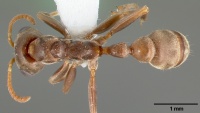Pseudomyrmex satanicus
| Pseudomyrmex satanicus | |
|---|---|

| |
| Scientific classification | |
| Kingdom: | Animalia |
| Phylum: | Arthropoda |
| Class: | Insecta |
| Order: | Hymenoptera |
| Family: | Formicidae |
| Subfamily: | Pseudomyrmecinae |
| Genus: | Pseudomyrmex |
| Species group: | ferrugineus |
| Species: | P. satanicus |
| Binomial name | |
| Pseudomyrmex satanicus (Wheeler, W.M., 1942) | |
Identification
Ward (1993) - The foregoing diagnosis will allow discrimination of P. satanicus workers from those of the closely related Pseudomyrmex spinicola; queens can be recognized by size alone (HL > 1.65, HW > 1.20). P. satanicus can be distinguished from the remaining members of the P. ferrugineus group by the emarginate, laterally angulate median clypeal lobe of the worker and the large size of the queen.
Distribution
Costa Rica and Panama.
Latitudinal Distribution Pattern
Latitudinal Range: 9.357° to 9°.
| North Temperate |
North Subtropical |
Tropical | South Subtropical |
South Temperate |
- Source: AntMaps
Distribution based on Regional Taxon Lists
Neotropical Region: Costa Rica, Panama (type locality).
Distribution based on AntMaps
Distribution based on AntWeb specimens
Check data from AntWeb
Countries Occupied
| Number of countries occupied by this species based on AntWiki Regional Taxon Lists. In general, fewer countries occupied indicates a narrower range, while more countries indicates a more widespread species. |

|
Estimated Abundance
| Relative abundance based on number of AntMaps records per species (this species within the purple bar). Fewer records (to the left) indicates a less abundant/encountered species while more records (to the right) indicates more abundant/encountered species. |

|
Biology
Ward (1993) - P. satanicus is a forest species restricted to a few localities in central Panama where its host plant, Acacia melanoceras, grows. Both the ant and plant are intolerant of forest clearance and are considered vulnerable to extinction (Janzen 1974). The ant is polygynous, with 5-20 or more queens per colony, and the workers are particularly aggressive, even for acacia-ants (Wheeler 1942; Janzen 1974). See Janzen (1974:43-53) for additional details on P. satanicus and its host plant.
Castes
Nomenclature
The following information is derived from Barry Bolton's Online Catalogue of the Ants of the World.
- satanicus. Pseudomyrma satanica Wheeler, W.M. 1942: 174, pl. 47, fig. b (w.q.m.) PANAMA. Combination in Pseudomyrmex: Kempf, 1972a: 223. See also: Ward, 1993: 149.
Unless otherwise noted the text for the remainder of this section is reported from the publication that includes the original description.
Description
Worker
Ward (1993) - measurements (n=15). —HL 1.16-1.36, HW 1.10-1.26, MFC 0.035-0.057, CI 0.90-0.97, REL 0.45-0.50, REL2 0.48-0.52, OOI 0.92-1.67, VI 0.69-0.78, FCI 0.030-0.049, SI 0.45-0.49, SI2 0.88-1.00, NI 0.63-0.68, PLI 0.47-0.54, PWI 0.46-0.63, PPWI 1.35-1.54.
Similar to Pseudomyrmex spinicola (q.v.) except as follows. Larger (HW > 1.09), head broader (CI > 0.88) with straight or slightly concave posterior margin and subangulate posterolateral corners. (The posterior margin of the head approaches this condition in some P. spinicola workers but these have much smaller, more elongate heads, HW < 1.10, CI < 0.90.) Median clypeal lobe narrower (CLW/HW 0.20-0.22). Palp formula 4,3. Head with pronounced pit-like impression below the median ocellus (absent or poorly developed in P. spinicola). Metanotal groove better developed, longer. Petiole tending to be more slender, with less distinct posterolateral corners (this characteristic seen in some workers of P. spinicola, especially individuals from Panama). Body pubescence averaging thicker than in P. spinicola. Dark brown in color, mandibles and appendages lighter.
Type Material
Ward (1993) - Syntype workers, queen, male, Rio Agua Salud, Canal Zone, Panama (W. M. Wheeler) (American Museum of Natural History, Los Angeles County Museum of Natural History, Museum of Comparative Zoology) [Examined]. One MCZC syntype worker here designated LECTOTYPE.
References
- Kempf, W. W. 1972b. Catálogo abreviado das formigas da regia~o Neotropical. Stud. Entomol. 15: 3-344 (page 223, Combination in Pseudomyrmex)
- Ward, P. S. 1993. Systematic studies on Pseudomyrmex acacia-ants (Hymenoptera: Formicidae: Pseudomyrmecinae). J. Hym. Res. 2: 117-168 (page 149, see also)
- Ward, P.S. 2017. A review of the Pseudomyrmex ferrugineus and Pseudomyrmex goeldii species groups: acacia-ants and relatives (Hymenoptera: Formicidae). Zootaxa 4227: 524–542 (doi: 10.11646/zootaxa.4227.4.3).
- Wheeler, W. M. 1942. Studies of Neotropical ant-plants and their ants. Bulletin of the Museum of Comparative Zoology 90: 1-262 (page 174, pl. 47, fig. b worker, queen, male described)
References based on Global Ant Biodiversity Informatics
- Ward, P.S. 1993. Systematic studies on Pseudomyrmex acacia-ants (Hymenoptera: Formicidae) Journal of Hymenoptera Research 2(1):117-168
- Wheeler W. M. 1942. Studies of Neotropical ant-plants and their ants. Bulletin of the Museum of Comparative Zoology 90: 1-262.

